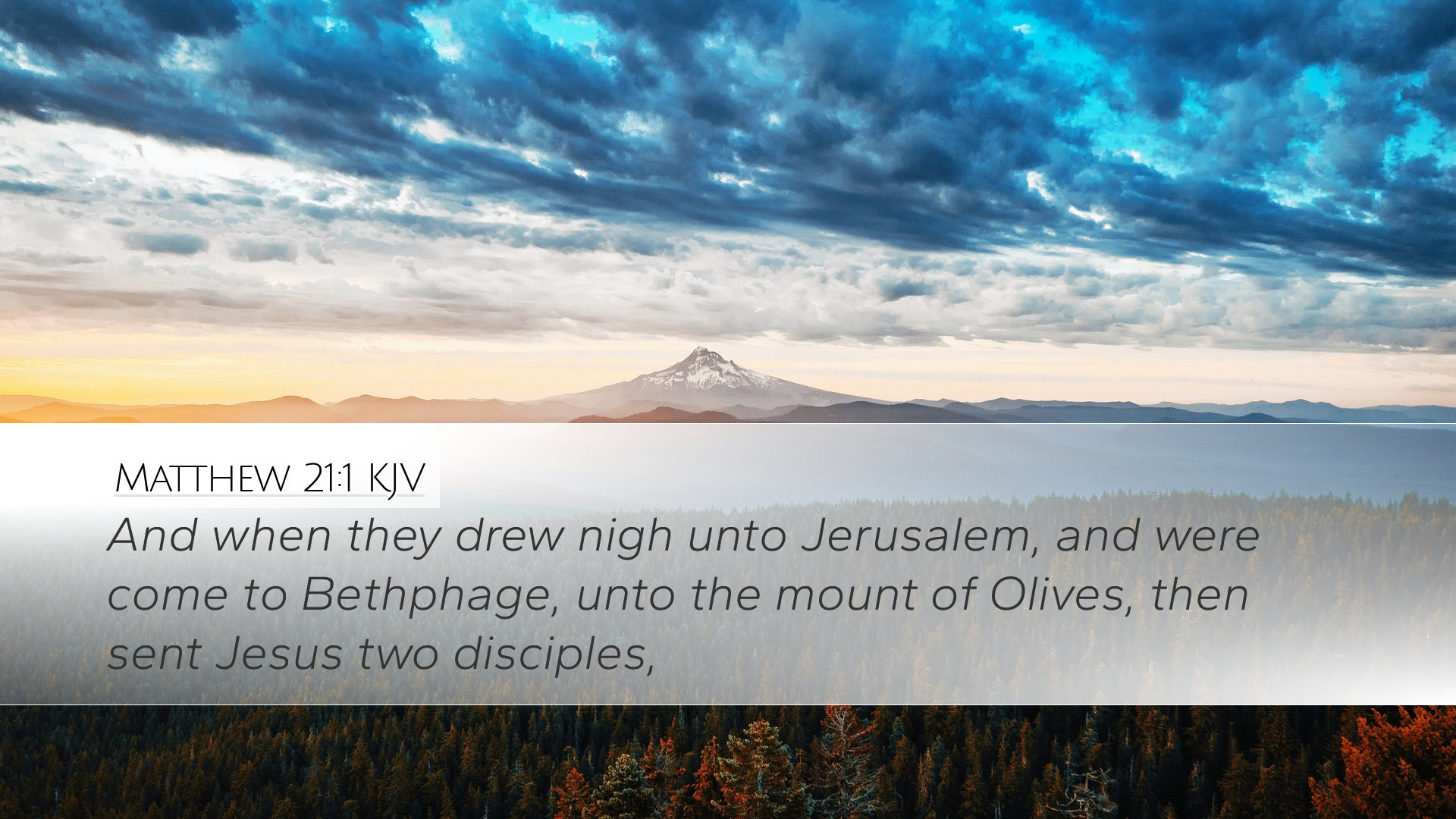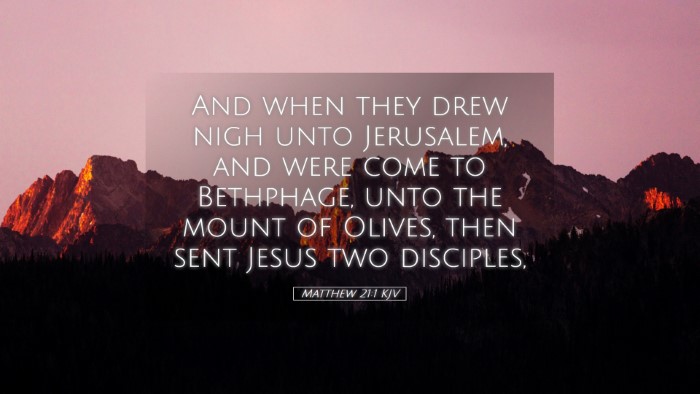Commentary on Matthew 21:1
Matthew 21:1 states: "And when they drew nigh unto Jerusalem, and were come to Bethphage, unto the mount of Olives, then sent Jesus two disciples." This passage marks a significant moment in the Gospel narrative, signifying the approach of Christ to His final days on Earth, culminating in His crucifixion and resurrection.
Contextual Background
In the Gospel of Matthew, this verse serves as a transition point, moving from the preceding teaching and miracles into the climax of Jesus’s ministry. Jesus' entry into Jerusalem fulfills Old Testament prophecies and establishes His kingship. The geographical setting is notable as Jesus approaches Jerusalem, which is significant in Jewish culture and religion.
Insights from Public Domain Commentaries
Matthew Henry Commentary
Matthew Henry emphasizes the importance of the location—Bethphage, situated on the Mount of Olives, a place rich with prophetic significance. He describes how this location not only provides a vantage point overlooking Jerusalem but is also linked with prophetic utterances regarding the Messiah. He notes that Jesus purposefully approaches the city as the time of His passion approaches, revealing His unwavering commitment to fulfilling His earthly mission.
Henry also points out the act of sending disciples to procure a colt for His entry into Jerusalem. He highlights the obedience of the disciples in responding to Jesus' commands, which reflects a key theme throughout the New Testament—faithful discipleship. The act itself symbolizes humility, contrasting with worldly expectations of regal entry.
Albert Barnes' Notes on the Bible
Albert Barnes provides detailed insights into the textual references, describing Bethphage as a village on the eastern slope of the Mount of Olives. He describes how the location's name means "house of unripe figs," symbolizing a place that had not yet borne its full fruit, a metaphor for Israel's unfulfilled promise at that time.
Barnes also delves into the cultural context of Jesus sending two disciples to acquire the donkey. He notes that the fulfillment of the prophecy from Zechariah 9:9 is a critical theological underpinning of this moment. The passage highlights the prophetic nature of Jesus’s actions and His role as the Messiah who comes in peace, riding a humble beast rather than a war horse.
Adam Clarke's Commentary
Adam Clarke elaborates on the specific instructions Jesus gives to His disciples regarding the colt. Clarke expresses wonder at the pre-ordained knowledge of Christ, as He instructs the disciples to find the animal and assures them of its eventual acceptance by its owner. This act portrays Jesus as sovereign and in control, emphasizing His divine nature.
Clarke further emphasizes the theological implications of this event, relating it to the overarching narrative of redemption. He notes that Jesus' entry into Jerusalem as a humble king is emblematic of God's kingdom, which subverts worldly power structures and serves a deeper purpose of restoration and peace.
Theological Implications
The events surrounding Matthew 21:1 invite believers to consider the nature of Jesus as both King and servant. The choice to ride on a colt—a young donkey—speaks volumes about the character of Christ's kingdom. This moment sets the stage for a theology of humility, servanthood, and the unexpected pathways of divine purpose.
- Fulfillment of Prophecy: This act directly fulfills Zechariah 9:9, demonstrating that Jesus is the anticipated Messiah.
- Symbolism of the Donkey: The donkey represents peace; Jesus comes not to incite war but to inaugurate a new kind of kingdom.
- Obedience of the Disciples: The willingness of the disciples to follow Jesus’ instructions exemplifies the nature of faithful discipleship.
- Location's Significance: The Mount of Olives and its surrounding areas are deeply entrenched in Jewish eschatological hopes and prophecies.
Concluding Thoughts
The narrative initiates a profound reflection for all who study scripture, challenging each reader to contemplate their own response to Jesus collectively with the world. Matthew 21:1 serves not only as an account of Christ's journey but also invites pastors, students, theologians, and scholars to recognize the layered meanings and implications of Christ's reign—a reign marked by humility, sacrifice, and unfailing love.


